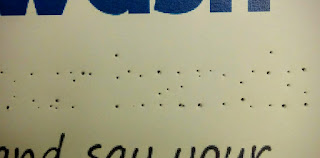Some time back I was working on decorating my bathroom wall. After hanging my Mom's cross-stitch, my kids' Perler creations, and a couple other bits and pieces, I felt like it needed something more. I remembered an amusing little saying I'd seen in a friend's bath: "Wash your hands and say your prayers, 'cause Jesus and germs are everywhere!" This seemed perfect for the space.
Since my grouping has several stitched pieces, I started by looking for (free) cross-stitch patterns with the saying. What I found wasn't free, and most had additional pictures or motifs that didn't fit my grouping. I briefly investigated online cross-stitch pattern makers, but the project was getting bigger and bigger as I planned and played. What I wanted was something more than simple print art, but achievable in just an hour or two of crafting. So I compromised with this easy hybrid print and stitch project.
It may not be terribly obvious from a small photo, but the words "your hands," "prayers," and "Everywhere" are stitched, while the others are printed. The whole thing - including making the templates - only took 2-3 hours. But I'm giving you my templates, so it will be even faster for you!
At the end of the tutorial I'll also give a few tips for composing your own templates for stitchable print-art.
Materials and tools
- These Images: Canvas (Color), Canvas (B&W), Template
- Printer
- Colored card stock, fairly heavy.
- Embroidery floss in coordinating colors
- Scrap piece of heavy cardboard at least 8.5 x 11
- Thumb-tack, push-pin, or quilter's pin
- Scissors for paper and thread
- Embroidery or cross-stitch needle (blunt is fine.)
- 5x7 frame for your finished project
1. Download and print the two images.
- The first image contains the entire saying and will serve as your stitching template. Print it on plain paper.
- The second image is you actual "canvas." Chose either the color or B&W canvas image. Print it on your card stock, making sure to change your printer's settings for heavy paper if necessary. (My laser printer goes all smeary if I forget to change the settings for card stock!)
2. Make your stitching template
- Lightly tape or pin your card stock image to your scrap cardboard
- Position your template image Exactly on top of the card-stock, using the printed border to ensure alignment. Tape or pin it down too.
- Now this is where it gets tricky.
Using a push pin (my favorite, but anything small and sharp will work), poke a hole for the beginning and end of each stitch you'll need to make your words.
"But how do I know where my stitches will begin and end?!" you ask. Well, there's a bit of an art to it, but you'll want to think of it as making a dot-to-dot.
The obvious places are at the beginning and end of each line, and at each intersection in a letter (i.e. each bar of capital 'E'). My recommendation is to use a single stitch for long vertical lines (i.e. the top half of lowercase "h.") Multiple stitches on a straight line are very hard to get even, even when using a template.
Curved and round letters are trickier: you need enough stitches to make it appear rounded instead of choppy, but not so many you risk ripping the paper by putting the holes too close together. I ended up with 7 or 8 holes for my "o." Lowercase "r" was the most challenging for me, since I didn't want it to look like a "v" when I was done. I put in some very short stitches. - When you're done, take your template off your card stock, but don't discard it: you'll find you need to refer to it for stitching. You will have something that looks like this:
3. Back-Stitch words onto the card stock.
- If you aren't familiar with this nice, simple stitch, check this little tutorial at "Sublime Stitching."
- I used two strands of thread, but feel free to experiment.
- Refer to your template frequently, because your eye is going to have a really hard time making anything sensible out of your little dot-to-dot!
4. Carefully cut out your finished project along the lines, and pop it in a frame. All done!
This is a fun little technique, and if you want to spend the time, there's no reason you couldn't stitch an entire project on paper rather than selected words. It might also be fun to experiment with stitching around the perimeter of block letters, or adding flowers or other embellishments. The sky's the limit!
If you are preparing your own templates, be sure to select a nice, clean, and especially lightweight font for stitching.
I used the free image program "Gimp" to make my templates. It's a full-featured editor, though, and not for the faint of heart.
I have not tried the online editor Canva yet, but if you're not familiar with Gimp you could give it try. You have to sign up (it's free), but you can create and what you need directly from the web.
Here is a tutorial I found on using Canva to create Bible Verse printables. Which, come to think of it, might be pretty fun to stitch!
Hey, let me know what you come up with. I'd love to see your projects!


















